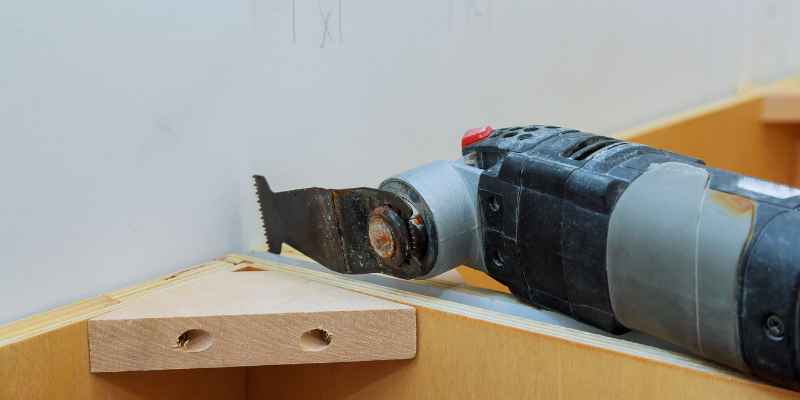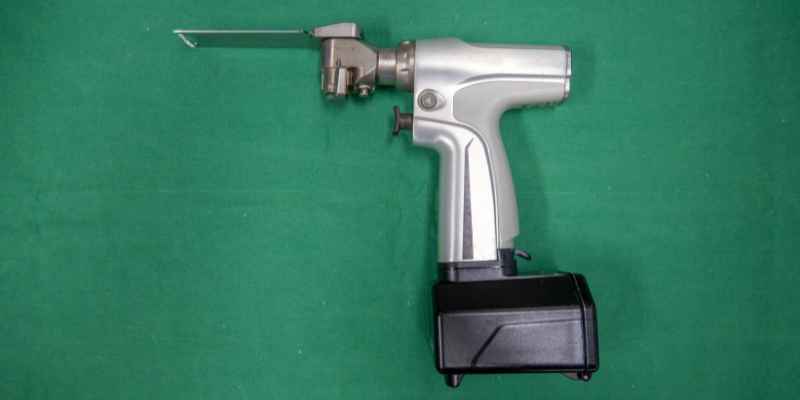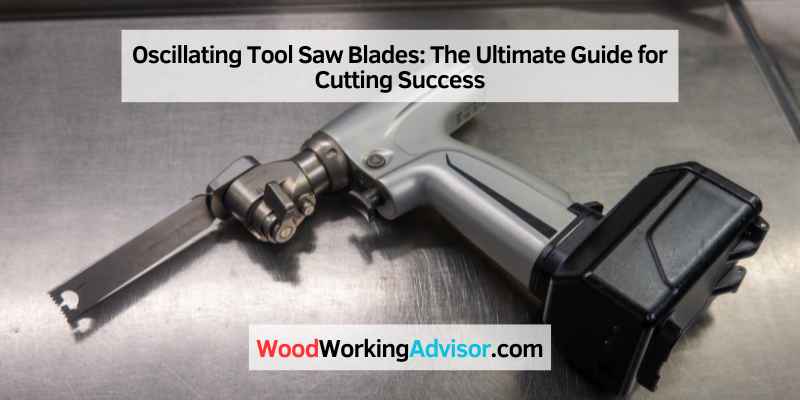Oscillating tool saw blades are versatile attachments used for a variety of cutting tasks. They provide precise and efficient cutting action, making them ideal for both professional and DIY projects.
With their oscillating motion, these blades can tackle different materials such as wood, metal, plastic, and even grout, making them a must-have tool for any handyman or contractor. Whether you need to make a plunge cut, flush cut, or remove grout, oscillating tool saw blades offer the versatility and reliability to get the job done quickly and accurately.
Upgrade your cutting game with the right blade for your oscillating tool and elevate your project to the next level.

Types Of Oscillating Tool Saw Blades
Oscillating tool saw blades come in various types suited for different materials and cutting needs. Let’s explore the Types of Oscillating Tool Saw Blades in detail:
Wood Cutting Blades
Wood cutting blades are designed for cutting through wood materials. They typically have fine teeth for smooth cuts in wood.
Metal Cutting Blades
Metal cutting blades are specifically crafted for cutting through various metal types. These blades are robust and durable for metalworking tasks.
Tile Cutting Blades
Tile cutting blades are well-suited for cutting tiles efficiently. These blades have a design that minimizes chipping on tile surfaces.
Factors To Consider When Choosing A Blade
When choosing oscillating tool saw blades, consider the material you’ll be cutting, the blade’s tooth count, and compatibility with your tool. It’s crucial to select the right blade type for optimal performance. Remember to prioritize quality over price for lasting results.
When it comes to using an oscillating tool, one of the most important factors that can make or break your project is choosing the right blade. The blade you use will determine the cutting efficiency, accuracy, and overall performance of your tool. With a wide range of options available in the market, it’s vital to understand the essential factors to consider when selecting an oscillating tool saw blade.
Material Compatibility
One of the first factors to consider is the material compatibility of the blade. Different blades are designed to cut through specific materials, such as wood, metal, drywall, or plastic. It’s crucial to choose a blade that is compatible with the material you plan to work on to ensure optimal cutting performance.
Tooth Count And Blade Width
Tooth count and blade width are important considerations that directly impact the cutting efficiency and precision of your oscillating tool. The number of teeth on the blade determines the speed and aggressiveness of the cut, and the blade width determines the width of the cut. A higher tooth count is typically ideal for finer and smoother cuts, while a lower tooth count is more suitable for rough cuts and quick material removal. Similarly, the blade width should match the width of your cutting task to ensure accurate and controlled cutting.
Blade Durability
Blade durability is a critical factor to consider, especially if you’re dealing with tough materials or planning to use the blade for extended periods. Look for blades that are made from high-quality materials and have a strong construction to withstand the demands of your projects. A durable blade will not only last longer but also ensure consistent performance, reducing the need for frequent replacements.
Remember, choosing the right oscillating tool saw blade is essential for achieving the best results and maximizing the efficiency of your projects. Take the material compatibility, tooth count, blade width, and durability into consideration when selecting a blade, and you’ll be on your way to achieving precise and flawless cuts with your oscillating tool.
Using Oscillating Tool Saw Blades Safely
When it comes to using oscillating tool saw blades, safety should always be a top priority. Understanding how to use these tools safely can prevent accidents and ensure a successful outcome for your projects. Let’s take a look at some essential safety guidelines and precautions you should keep in mind while using oscillating tool saw blades.
Safety Gear And Precautions
Before starting any task with an oscillating tool saw blade, make sure to prioritize your safety by wearing the necessary gear. This includes protective eyewear, gloves, and a dust mask to shield yourself from any potential hazards during operation. Additionally, it’s important to secure your workpiece properly to prevent any unexpected movement that could lead to an accident.
Proper Blade Installation
When it comes to ensuring safety, proper blade installation is key. Before attaching the blade, always ensure that the tool is unplugged or the battery is removed to avoid accidental activation. Properly align the blade with the tool’s interface and securely fasten it in place before use. Check for any loose screws or components, and confirm that the blade is positioned securely to prevent any mishaps during operation.
Maintaining And Caring For Saw Blades
Proper maintenance of oscillating tool saw blades is crucial to ensure longevity and performance. Regular cleaning, sharpening, and proper storage can extend the lifespan of saw blades, ultimately saving time and money for the user. It’s essential to inspect the blades for any signs of wear and tear and address them promptly.
Maintaining and caring for oscillating tool saw blades is essential to ensure their longevity and optimal performance. Proper care can prolong the life of the blades, maximize their cutting efficiency, and ultimately save you time and money. Cleaning and Storage Tips, as well as regular sharpening, are crucial aspects of blade maintenance to keep them in top condition.
Cleaning and Storage Tips
Proper cleaning and storage play significant roles in preserving the quality of oscillating tool saw blades. Here are a few straightforward tips that can help you maintain the blades:
1. Clean your saw blades after every use using a wire brush or a blade cleaning solution. Ensure all debris and residues are removed to prevent corrosion and blade dullness.
2. After cleaning, thoroughly dry the blades to prevent rusting. Utilize a clean cloth to remove any excess moisture before storing them.
3. Store the saw blades in a dry environment to prevent exposure to moisture, which could lead to oxidation and rust.
4. Use blade covers or protective cases to store the blades when not in use. This aids in preventing damage and maintains the sharpness of the blades.
Regular sharpening is paramount for ensuring the blades maintain their cutting efficiency. Sharpening tools such as sharpening stones or dedicated blade sharpeners can be employed to maintain the sharpness of the blades. Follow these basic steps for sharpening your oscillating tool saw blades:
1. Secure the blade in a vice to stabilize it during the sharpening process.
2. Use a consistent angle while sharpening, typically matching the existing bevel on the blade.
3. Apply even pressure and use smooth, steady strokes while sharpening to achieve an even edge.
4. After sharpening, ensure the blade is thoroughly cleaned and dried before storage to prevent any potential corrosion.
Taking these steps to maintain and care for your oscillating tool saw blades will not only extend their lifespan but also ensure a consistently high level of performance. Remember, a well-maintained blade is crucial for achieving precise and efficient cutting results.
Tips And Techniques For Cutting Success
When it comes to using oscillating tool saw blades, there are a few tips and techniques that can help you achieve cutting success. Whether you’re a DIY enthusiast or a professional tradesperson, understanding how to optimize the cutting speed, work with different materials, and troubleshoot common issues can make all the difference. In this article, we will explore these topics in depth to ensure your cutting projects go smoothly.
Optimal Cutting Speed
One of the keys to achieving clean and efficient cuts with an oscillating tool saw blade is maintaining an optimal cutting speed. The speed at which you move the tool along the material can affect the quality of the cut and the overall performance. Here are a few tips to help you find that sweet spot:
- Start slow: When beginning a cut, it’s generally best to start at a slower speed. This allows you to maintain better control and accuracy.
- Gradually increase speed: As you gain confidence and the blade engages with the material, you can gradually increase the speed to improve cutting efficiency.
- Let the blade do the work: Avoid pushing down too hard on the tool. Instead, let the oscillating motion of the blade and the tool’s weight do the cutting for you. This can help prevent damage to the blade and prolong its lifespan.
Cutting Different Materials
One of the advantages of oscillating tool saw blades is their versatility in cutting various materials. However, different materials may require different techniques to achieve optimal results. Here are some tips for cutting common materials:
| Material | Technique |
|---|---|
| Wood | Use a fine-toothed blade for clean cuts. Move the tool in a controlled, steady motion to prevent splintering. |
| Metal | Choose a bi-metal or carbide-toothed blade for durability. Start with a slower speed and increase gradually to avoid overheating and blade wear. |
| Tile | Opt for a diamond-grit blade for efficient tile cutting. Apply gentle pressure and let the blade work its way through the material. |
Troubleshooting Common Issues
Despite your best efforts, it’s not uncommon to encounter some issues while using oscillating tool saw blades. Here are a few troubleshooting tips to overcome common challenges:
- Blade getting stuck: If your blade gets stuck in the material, try reducing the cutting speed or changing to a more appropriate blade for the material.
- Poor cutting performance: If the blade isn’t cutting efficiently, make sure it’s properly attached to the tool. Replace the blade if it’s worn or damaged.
- Excessive vibration: Too much vibration can affect cutting accuracy. Check that the blade is securely fastened and inspect the tool for any loose components.
Innovations In Oscillating Tool Saw Blades
Oscillating tool saw blades have seen remarkable advancements in recent years. From bi-metal blades that offer superior durability to carbide blades designed for precision cutting, there is a wide array of new blade technologies available.
Manufacturers are now producing oscillating tool saw blades tailored for specific applications. Whether you need a blade for metal cutting, woodworking, or tile removal, there is a specialized solution to meet your needs.

Frequently Asked Questions On Oscillating Tool Saw Blades
What Are Oscillating Tool Saw Blades Used For?
Oscillating tool saw blades are used for cutting, scraping, sanding, and grinding various materials such as wood, metal, plastic, and tile. They are versatile accessories that can be used for a wide range of applications in construction, woodworking, remodeling, and DIY projects.
How Do I Choose The Right Oscillating Tool Saw Blade?
To choose the right oscillating tool saw blade, consider the material you will be working with and the type of cut or action required. Look for blades with the appropriate tooth pattern, size, and material compatibility for the specific task at hand.
Always refer to the tool’s manual for compatibility recommendations.
Can Oscillating Tool Saw Blades Be Used For Plunge Cutting?
Yes, oscillating tool saw blades are ideal for plunge cutting due to their oscillating motion, which allows for precise and controlled cutting in tight spaces. When using the tool for plunge cutting, be sure to use the appropriate blade for the material and follow safety guidelines to avoid kickback and ensure accuracy.
What Are The Advantages Of Using Carbide-tipped Oscillating Tool Saw Blades?
Carbide-tipped oscillating tool saw blades offer enhanced durability and longevity, making them ideal for cutting through harder materials such as hardwood, metal, and concrete. Their resistance to wear and heat allows for efficient cutting and better performance, especially in demanding applications.
Conclusion
To sum up, oscillating tool saw blades are versatile and essential accessories for woodworkers. With their ability to cut through various materials effortlessly, they offer convenience and efficiency in completing a range of tasks. Whether you are a professional or a DIY enthusiast, investing in high-quality saw blades can significantly enhance your workmanship and deliver exceptional results.
So, choose the right saw blades for your oscillating tool and take your woodworking skills to the next level.


